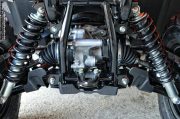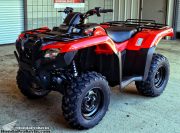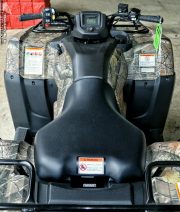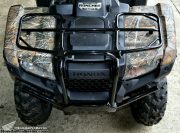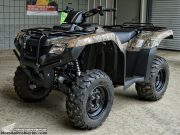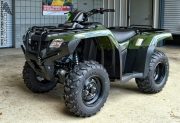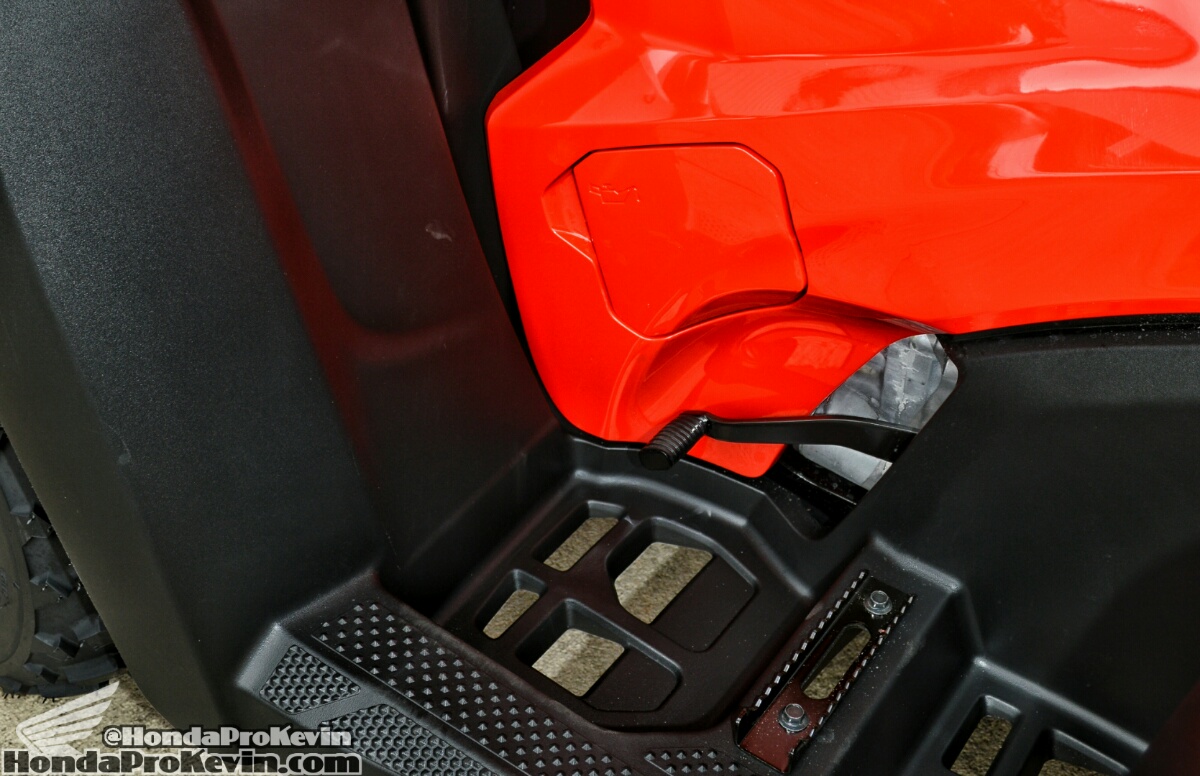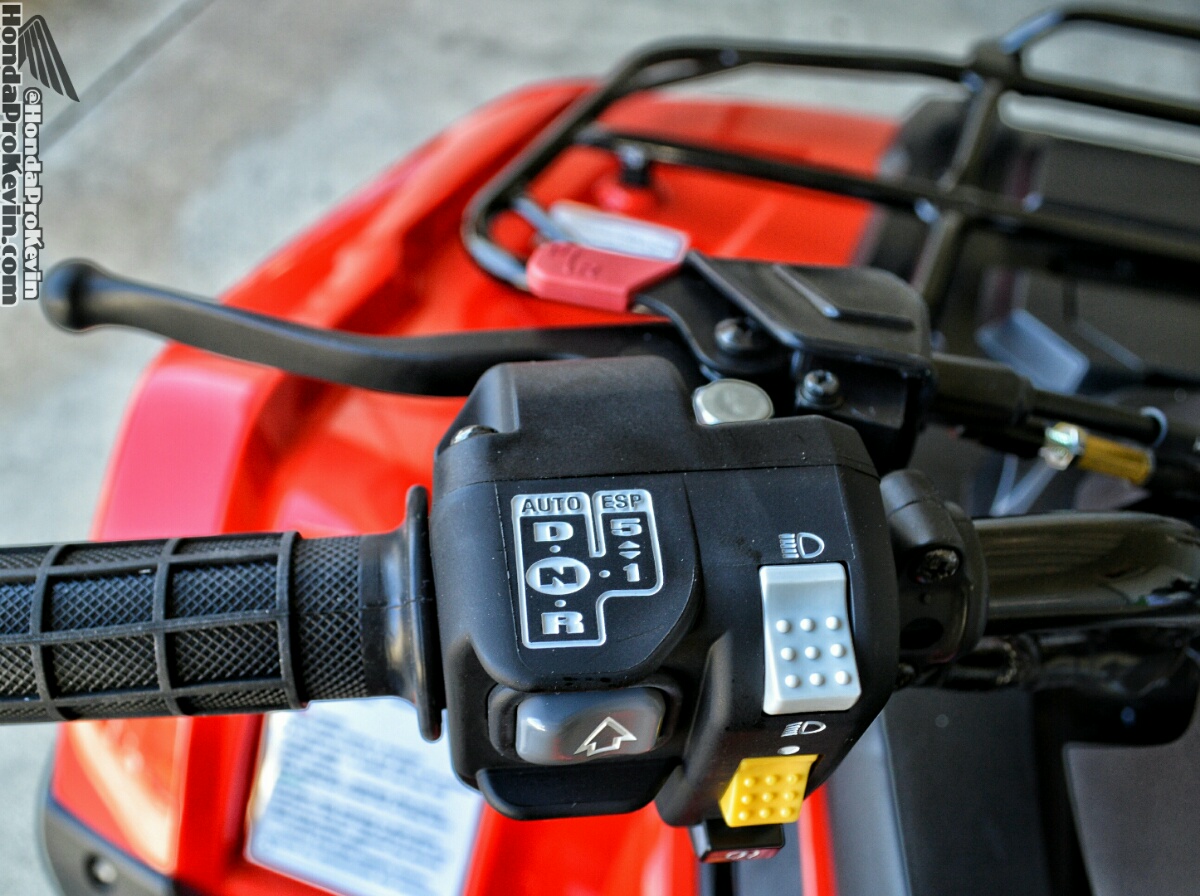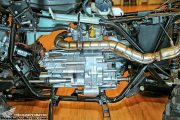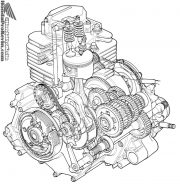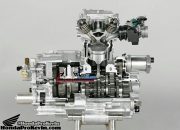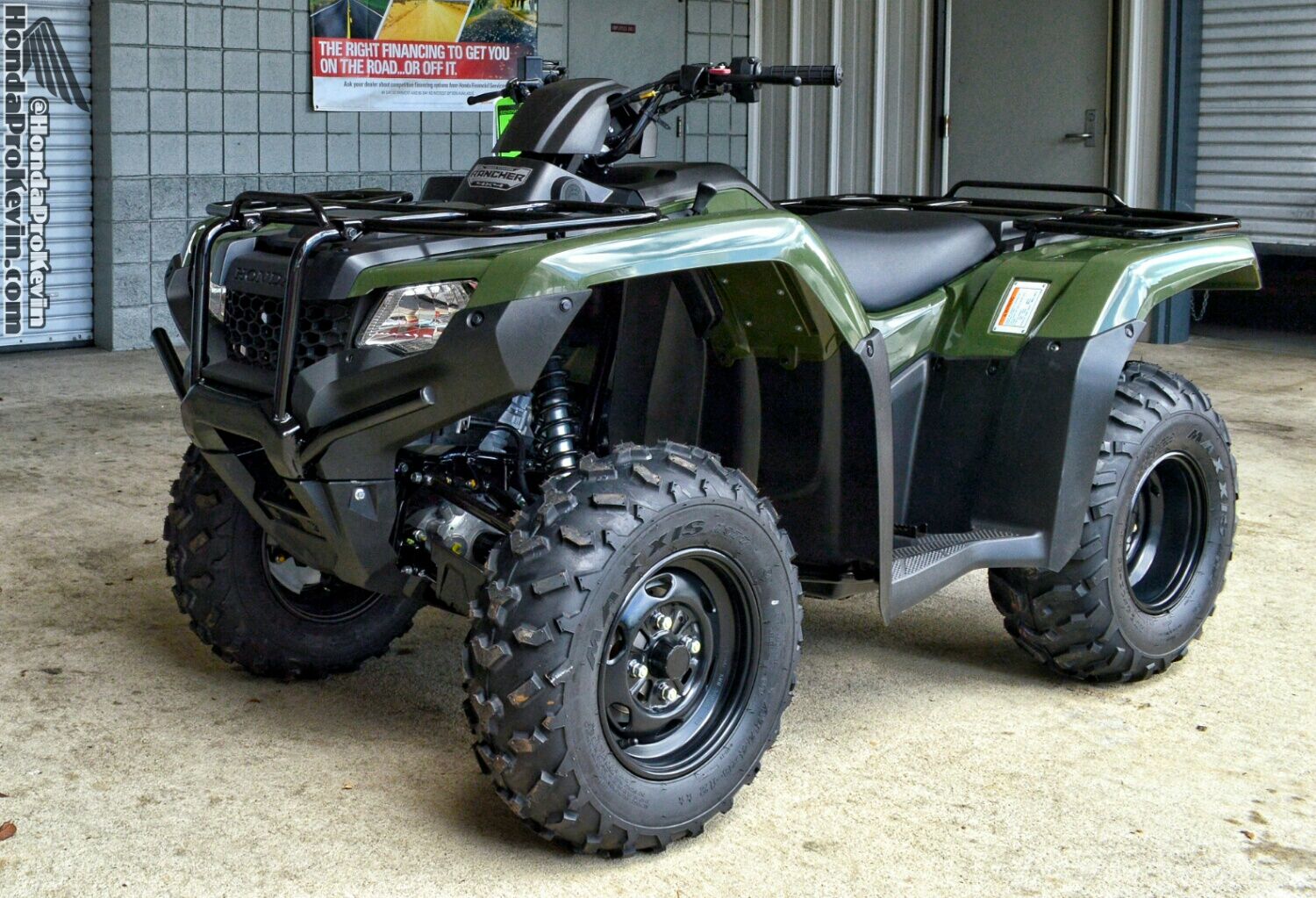
2016 Honda Rancher ES 420 4×4 Review / Specs / Pictures / Videos
– 2016 Honda FourTrax Rancher ES 4×4 (TRX420FE1G) –
When it comes to the 2016 Honda TRX420 Rancher ATV model lineup you have enough options in the model variations to make it rather confusing. Are looking for an explanation on all of Honda’s model ID’s and want to know what TRX420FE1G means for this specific Rancher? If so, go here —-> Honda ATV Model Names Explained – Click Here. Want to see all of the 2016 Rancher model options available and their explanations? If so, go here —-> Rancher 420 Model Lineup Differences / Explained – Click Here. Those two links will help you decide which model will suit your needs the best. Once you’ve figured out which model then the Rancher 420 reviews below and all of the other specific Rancher model pages will make more sense.
Now, we’ll get to the 2016 Honda Rancher ES 420 4×4 (TRX420FE1G). This particular model is the ES (Electric Shift) version of the 2016 Rancher 420. When I say Electric Shift, I’m referring to how you shift gears. With the Electric Shift model, you change gears by clicking an UP and DOWN arrow button on the left side of the handlebar. There is no clutch on this model, just click up and down with your thumb to change gears. If you don’t want the ES model, Honda also makes the fully automatic DCT Rancher and the manual / foot-shift Rancher 420.
- 2016 Rancher 420 ES ATV Horsepower: 26.6 HP @ 6,250 RPM
- 2016 Rancher 420 ES ATV Torque: 24.6 lb/ft TQ @ 5,000 RPM
- 2016 Rancher 420 ES ATV Miles Per Gallon: 41.4 MPG
————————
Honda Rancher ATV Model ID / Code Key:
- TRX – Generic prefix for all Honda ATV Sport / Utility 2WD & 4WD models
- 420 – 420 cc engine
- T – Two Wheel Drive
- F – Four Wheel Drive
- A – Fully Automatic (DCT Transmission)
- M – Manual Shift
- E – Electric Shift – Automatic
- 1 – No Power Steering / EPS
- 2 – Power Steering / EPS
- 5 – IRS / NO Power Steering (EPS)
- 6 – IRS / Power Steering (EPS)
- G – 2016 Model Year
- DCT – Dual Clutch Transmission (Fully Automatic Transmission with Electric Shift option option to manually change gears via the ESP)
- AT – Automatic (Fully Automatic Transmission with Electric Shift option to manually change gears via the ESP)
- EPS – Electric Power Steering
- ESP – Electric Shift Program (Normally referred to as ES)
- ES – Electric Shift
- IRS – Independent Rear Suspension
- FourTrax – Honda uses this as a generic model name for all of their utility ATV models in the lineup. Some confuse FourTrax as a certain model from Honda or that it means 4×4 but that is not the case as even 2×4 models use FourTrax.
* All Utility style ATVs (with racks) are automatic in the sense that they don’t have a clutch to use, commonly referred to as having a semi-automatic clutch.
* IRS is only available on DCT model Rancher
Model EXAMPLE: TRX420FE1G
Now lets put the key above to use… What is a TRX420FE1G? It is a 420 Rancher Four Wheel Drive and Electric Shift without EPS and is a 2016 model. TRX = ATV / 420 = 420cc / F = Four Wheel Drive / E = Electric Shift / 1 = No EPS / G = 2016.
2016 Honda Rancher 420 ATV Transmission Options:
- Manual / Foot Shift (No clutch)
- ES / Electric Shift – Change Gears manually by clicking an Up and Down button on the left handlebar
- DCT / Automatic – Fully Automatic so you can just hit the gas and go
2016 Honda TRX420 Rancher Color Options
TRX420TM / TXR420TE: Red, Olive (Green)
TXR420FM1 / TRX420FM2 / TXR420FE1: Red, Olive (Green), Phantom Camo
TRX420FA1 / TRX420FA2: Blue, Red, Olive (Green), Phantom Camo
TXR420FA5 / TRX420FA6: White, Red, Phantom Camo
* Phantom Camo available on 4×4 models $450 MSRP / Price increase
Over the years, Honda’s liquid-cooled fuel-injected 420 cc FourTrax Rancher ATV series has built a huge number of loyal followers and for good reason. Whether the day calls for multiple tasks on a job site, chores around the homestead or a ride in the woods just for fun, the Rancher formula really hits a sweet spot by combining hard-working full-size ATV capabilities in a package with manageable dimensions. These are incredibly versatile machines packed full of Honda quality and reliability, and the Rancher’s pricing makes each model a real value in today’s market.
In large part, credit for the Ranchers’ extreme popularity and versatility must go to the multiple drivetrain configurations available to meet most any rider’s checklist. Honda just recently did a complete overhaul on the Rancher 420 model lineup from the frame up adding even more options and features than ever before. The FourTrax Rancher models feature an all-new chassis with a redesigned frame featuring new, longer-travel suspension plus a lot more, new IRS design etc. In addition, that new chassis can be easily identified because it’s wrapped in all-new bodywork with distinctively aggressive styling and added functionality.
When deciding on which model Rancher is the best to buy for your needs, I would start with the transmission decision first as all the other features go from there. As you can’t get some features with certain transmissions. Example: you can’t have a Manual / Foot Shift transmission with IRS or you can’t get an ES model with EPS. If you want IRS then you have to go with the DCT transmission and if you want EPS with EPS you’ll have to go with DCT which still gives you that Electric Shift feature as you don’t have to use the fully automatic mode on the DCT model Rancher. Confused yet haha? Let’s get started on explaining it all.
2016 Honda Rancher 420 Transmission Options
Now you have more options than ever when it comes to deciding what transmission choice is best for you and what you’ll be doing with your new Rancher ATV.
Below, I’ll go over your (3) different transmission options in-depth with details on how they work etc. Honda’s unbeatable variation in drivetrain styles in this series gives consumers an extraordinary variety in choices: The two-wheel-drive FourTrax Rancher is available with a Manual / Foot Shift transmission or in ES configuration, featuring Honda’s highly regarded Electric Shift Program (ESP) that makes gear shifts as easy as touching a button; the FourTrax Rancher 4×4 (TRX420FM1) adds TraxLok 4WD capabilities; the FourTrax Rancher 4×4 ES (TRX420FE1) adds ESP push-button shifting to that 4WD equation; and the Rancher 4×4 Automatic DCT (TRX420FA) features Honda’s heralded Automatic Dual Clutch Transmission (DCT), a five-speed fully automatic transmission that also gives the rider the option of ESP mode.
- Manual / Foot Shift Transmission (Semi-automatic with No clutch)
First, there’s a traditional manual-shift five-speed that has proven to be extremely durable and is still favored by many riders.
- Electric Shift (ES) / Electric Shift Program (ESP)
Next up, we have the Rancher with Honda’s Electric Shift Program (ESP) also commonly referred to as just Electric Shift (ES): a convenient alternative to the manual gearbox that makes gear shifts as easy as pressing the upshift or downshift button with your thumb. One large benefit to the ES option is that if you ever injured your left foot, leg, etc or ride with large boots you won’t have a problem with being able to change gears manually. With ESP, an onboard Electronic Control Module (ECM) monitors information from four sensors – engine rpm, countershaft speed, shift drum angle and shift spindle angle – to control the speed of the electric-shift motor’s gear and clutch engagement. Gear-engagement speed varies according to rider usage: The transmission shifts more quickly when the riding style turns sporty. A Neutral lockout at speeds greater than two mph ensures available engine braking when descending hills. For smooth shifting, the transmission cannot be shifted from Neutral to First gear or Reverse at engine speeds above 3000 rpm. ESP is not dependent on battery power; it operates whenever the engine is running. Should the rider ever need to shift manually, ES models are also equipped with an auxiliary shift lever in the toolkit. A lot of customers aren’t aware of this backup manual shifter just incase your ES should ever fail for any reason, Honda builds a backup to everything so you’ll never have to worry about your Rancher leaving you stranded in the woods.
- Dual Clutch Transmission / Automatic
A first in the world of ATVs, Honda’s premium Automatic Dual Clutch Transmission (DCT) in the Rancher 4×4 Automatic DCT model makes it a standout. The Rancher 4×4 Automatic DCT now employs a new-generation DCT with an elevated level of sophistication: new updated dual-zone shift logic offers improved adaptation to all riding conditions based on rider and vehicle inputs, effectively and intuitively adjusting shift points whether riding under normal or aggressive conditions. The result: the best-performing Automatic DCT we’ve ever put in an ATV that offers the right gear, at the right time, all the time, all automatically – to create a whole new level of riding compatibility. Thanks to this change, the DCT significantly reduces gear “hunting” – that is, shifting back and forth repeatedly between two gears—as it performs the most appropriate shift actions automatically. As a result, the net benefits to the rider are manyfold: better automatic transmission feel as the Rancher reacts more intuitively to the rider’s operational style and intentions; enhanced power feel; increased response; reduced engine lugging; plus less fatigue and more rider comfort.
The key to the DCT design is the innovative dual-clutch configuration coupled with a two-piece mainshaft. The first mainshaft has first, third and fifth gears all driven by the first clutch. The second mainshaft is sleeved over the first shaft. It carries second, fourth and reverse gears, and it’s driven by the second clutch. This designs allows two gears to be engaged at the same time, and each gear is pre-shifted before power is applied. Shifting is then accomplished by disengaging once clutch and engaging the other.
One advantage to this DCT system is extremely quick shifts for less driveline lurching between shifts, especially under load, which means the chassis attitude remains more consistent during gear changes. When engaging downhill slopes, this system also provides true controlled compression braking. In addition, this automatic five-speed transmission’s maintenance needs are greatly reduced, while power-transfer efficiency is improved to make the riding experience all the more enjoyable. Furthermore, since this DCT uses conventional transmission gears, it’s as rugged and durable as Honda’s conventional manual transmission. This fully automatic transmission also gives the rider the option of using the ESP push-button shifting mode as desired.
2016 Honda Rancher 420 4×4 TraxLok 4WD System
The Rancher 4×4 models also feature TraxLok selectable 2WD/4WD capabilities that enable the rider to quickly shift between the nimble handling of a 2WD and the extra traction of a 4WD ATV. TraxLok incorporates a two-way mechanical roller clutch with a series of hardened-steel rollers that lock up in a mere six degrees of rotation for a smooth, virtually instantaneous response while either accelerating or decelerating on flat ground or an incline. This system also operates in Reverse. To ensure smooth operation, the TraxLok system only engages when the speed differential between the front and rear wheels is less than six mph. Once engaged, the system remains engaged on downhills for true 4WD braking.
In addition, when TraxLok 4WD mode is engaged, a torque-sensitive limited-slip front differential reduces steering effort for a lighter feel. This torque-sensitive limited-slip front differential automatically sends power to whichever front wheel has the most grip. This system also allows both wheels to maintain essentially the same speed and drive regardless of traction conditions. It also virtually eliminates torque steer and drastically reduces the effort necessary to initiate a turn, thus shortening the turning radius and improving handling.
To top things off, the Rancher 4×4 model and 4×4 Automatic DCT Rancher also offer the option of Electric Power Steering. Below you’ll find a chart that helps with quick correlation between models and technical features, and in the accompanying sidebar you’ll find additional detailed information regarding these different transmission systems and TraxLok technology. But regardless of how you look at things, it all adds up to a wealth of wonderful Rancher choices for off-road work or play.
2016 Rancher Electric Power Steering
Honda’s Electric Power Steering (available on all 4×4 Rancher models) has torque sensors that measure how much force you’re applying and tailors how much extra assist you need. The specially engineered mounting system increases stiffness and enhances control even more. It makes your life way easier, especially when riding over ruts, rocks, logs, or on sidehills. Aboard the Ranchers that incorporate Honda’s Electric Power Steering, a new attachment layout using a three-point mount for the EPS mechanism makes the entire unit more rigid in its placement than ever before, and that makes for even more precise steering. This EPS system is a next-generation setup that incorporates new settings for improved linearity in steering response, reduced low-speed steering effort for enhanced maneuverability and decreased kickback traits for improved all-around steering action. The EPS feature when comparing MSRP to MSRP is an added cost of $700 to the price versus a non power steering model Rancher 420.
What makes EPS so revolutionary? Start with the power assistance, which means your Rancher takes significantly less effort to steer in all conditions. This is similar to the benefit of power steering in an automobile. What makes Honda’s EPS so significant in an ATV application is the amount of steering damping it provides, which means a significant reduction in the kickback through the handlebar that a rider feels when encountering a rock or other obstacle. Put simply: This system reduces the jarring in rough terrain. Rocks that normally try to deflect the wheels and create a workout for the rider can now be addressed with ease. The suspension moves up and down without the handlebars moving side to side. Yet through its multiple sensors and ATV-specific design, the system keeps you directly connected, offering great feedback and natural steering feel. And the system works at idle, which means you get maximum assistance when you find yourself wedged between a rock and a hard place. With EPS, you can more easily steer right out of these predicaments. With EPS, it reduces steering effort and damps out the majority of bump-induced jarring a rider feels in rough terrain, which can dramatically reduce rider fatigue. There is simply less for the rider to deal with, especially in rocky, rutted terrain.
For most people that means extended riding days. New riding areas and experiences will open up because this technology will make them more accessible to more people. It will make hauling loads easier for people who use their ATV for farming and other industrial applications, especially such chores as plowing or towing. It will allow people who are not as strong to extend their riding envelope of time and effort. EPS completely changes the ATV riding experience. While the system adds a couple of pounds to the weight of the standard Rancher 420, the EPS-equipped Rancher responds to rider inputs as if it were 75 pounds lighter. The Honda EPS system is mounted in line with the steering stem, and its 15-pound weight is carried low and close to the Foreman’s center of gravity so handling is not compromised. The lighter steering feel more than makes up for the extra weight. The self-contained ECU is carried in a tray just forward of the oil cooler. Adding icing to the cake, Honda’s EPS system is also self-contained, totally enclosed and watertight, eliminating the need for any maintenance whatsoever.
Is EPS / Electric Power Steering worth it on the Rancher? In my opinion, yes. It is worth its weight in gold but again that is just my opinion. When Honda first introduced EPS back in 2007 on the Foreman – I thought to myself “Why would anyone want power steering on an ATV?“. That was my thoughts on the EPS mechanism though until I finally had the change to ride the Rancher, Foreman and Rubicon with EPS and see it in action. If you don’t think that you want to spend the extra money for the power steering on your new Honda ATV – don’t ever ride one with EPS and you won’t know what you’re missing is my recommendation. It’s well worth the money the next day after trail riding for hours when you’re upper back and shoulders, arms etc aren’t sore. If you plan on keeping the ATV and riding it regularly, you’ll thank yourself for paying the extra $$ for the EPS. It’s not for everyone though and some don’t want EPS as they don’t want to worry about more electronics down the road and the possibility of it failing etc.
Some of the recent Rancher 420 Changes & Upgrades
The newer Ranchers incorporate a host of upgrades, starting with an all-new double-cradle steel frame developed with Computer Aided Engineering. This new frame features increased stiffness for even more precise handling, while more effectively transferring energy for a smoother ride.
An all-new swingarm with an enclosed rear axle was also developed to add strength and rigidity to the chassis. As another plus, this design allows the swingarm rather than the rear final gear bearings to support rear-wheel loads—a design that adds to driveline durability. This new swingarm mounts in new rubber swingarm pivot bushings that absorb input loads at the swingarm/frame junction, which adds to improved ride comfort. As a side benefit, since these rubber bushings are bonded to the inner and outer swingarm collars, dirt cannot enter into the swingarm pivot area – and that adds to long-term durability. In addition, this new rear axle setup locates the sealed mechanical rear drum brake inside the right rear wheel for improved protection and increased ground clearance. Larger, dual hydraulic disc brakes up front offer added stopping power.
This new chassis also incorporates brand-new suspension front and rear. The shocks feature new damping characteristics plus an increase in travel to 6.7 inches at both ends for a plush and controlled ride. These shocks also offer adjustable spring preload that allows for quick and easy suspension tuning to match varying loads and riding conditions. Also, new sealed steering knuckle bearings add extended durability and a full-length composite lower skidplate with integrated front brush guard add protection.
At the Heart of the Rancher
In the engine department, all Ranchers make good use of the rugged and proven OHV liquid-cooled, fuel-injected 420cc engine. In signature Honda style, these Rancher engines are longitudinally mounted to allow direct driveshaft alignment to both front and rear wheels for maximum drivetrain efficiency. The overhead-valve design provides compact engine dimensions for excellent ground clearance while maintaining a broad, easy-to-use powerband.
Newer mapping for the Programmed Fuel Injection (PGM-FI) system combined with new oxygen sensor feedback technology improves power delivery and throttle response, while also improving emissions and fuel efficiency for greater range and reduced tailpipe emissions. All models feature super-heavy-duty clutch construction for excellent driveability and towing capability. Downstream in the drivetrain, new tougher, plastic CV joint boots supply added durability thanks to their more puncture- and tear-resistant qualities.
Other recent changes on the latest generation TRX420 Rancher include a new fuel pump that is derived from Honda automobile technology; the pump mounts in the fuel tank for better heat isolation and offers an increase in filter life. All Ranchers feature increased AC output to support electrical accessory needs: most models see a 16 percent jump to 416 watts, while the Automatic DCT model gains 21 percent to 450 watts. A stainless-steel exhaust system includes a USDA-qualified spark arrester/muffler designed for quiet operation and long-lasting performance.
More and More Changes & Upgrades
Other more visible changes on the latest generation of the Rancher include an all-new one-piece tank/side cover that allows easy access for maintenance—no tools are required for removal. This newly styled bodywork also provides better mud protection for the rider. Buyers who choose the new Honda Phantom Camo scheme will find it not only provides excellent camouflage properties that help the ATV blend into a wide range of field environments, but new Honda application processes also provide better graphic adhesion, excellent durability and improved resistance to fuel spillage to keep things looking better, longer.
A new meter display for all models (excluding the manual-shift 2WD Rancher) features added functions: an electronic fuel gauge, clock, coolant temperature gauge and a “maintenance minder” system that tracks both hours of run time plus miles driven. Also, the twin-headlight system has been redesigned and now features 35-watt headlights with a more focused light distribution pattern for improved visibility after dark. And a newly optimized rider triangle promotes added comfort, while a 0.8 inch-increase in seat foam thickness and softer seat foam density add further to rider comfort.
Looking for a little added protection for your 2016 Rancher 420? Check out the Honda Aluminum A-Arm Guards front and rear as well as Skid Plate on the Rancher pictured below. It’s also outfitted with a Warn Vantage winch up front too.
As you can see, you’ve got more than enough model options on the 2016 TRX420 Rancher model lineup to help you fine-tune the features you want to better assist you in getting the ATV that’s perfect for you.
Which 2016 TRX420 Rancher is the best ATV out of all the options in the model lineup? There’s not a particular model that is better than the next. The “best” will be the model that has the features that fit your needs as they all have their options that set them apart.
Was this information helpful? If so, please Click “Like” and or Share below as it lets me know you guys want to see more posts like this. Thanks guys.
Below, you will find a quick breakdown on some of the Features & Specs between split into two categories below as that is the easiest way to split them up since technically they have different frames / suspension based on if it has IRS vs Straight-Axle.
Rancher 420 Models with a Straight Axle (TRX420TM / TRX420TE / TRX420FM1 / TXR420FM2 / TRX420FE1G / TRX420FA1G / TXR420FA2G)
Features:
- Double-cradle steel chassis with a redesigned frame developed with Computer Aided Engineering features increased stiffness (up 20 percent) for even more precise handling and a smoother ride.
- New front and rear suspension features an increase in travel to 6.7 inches at both ends, plus new shocks for a plush and controlled ride.
- Heavy-duty trailer hitch with 848-pound towing capacity.
- Twin-headlight system has been redesigned and now features 35-watt headlights with a more focused light distribution pattern for improved visibility after dark.
- Assembled in Timmonsville, South Carolina, using domestically and globally sourced parts.
- Transferable one-year limited warranty; extended coverage available with a Honda Protection Plan.
- All-new double-cradle steel frame developed with Computer Aided Engineering features increased stiffness (up 20 percent) for even more precise handling and a smoother ride.
- New front and rear suspension features an increase in travel to 6.7 inches at both ends plus new shocks for a plush and controlled ride.
- Honda TraxLok 2WD/4WD system offers two drive modes: 2WD and 4WD with TraxLok torque-sensing front differential.
- Optional Electric Power Steering (EPS) system is a next-generation setup that incorporates new ECU mapping for improved linearity in steering response, reduced low-speed steering effort for enhanced maneuverability and decreased kickback traits for improved all-around steering action.
- Heavy-duty trailer hitch with 848-pound towing capacity.
- Twin-headlight system has been redesigned and now features 35-watt headlights with a more focused light distribution pattern for improved visibility after dark.
- Assembled in Timmonsville, South Carolina, using domestically and globally sourced parts.
- Transferable one-year limited warranty; extended coverage available with a Honda Protection Plan.
Engine / Drivetrain:
- Rugged OHV liquid-cooled, fuel-injected 420cc longitudinally mounted engine allows direct driveshaft alignment to both front and rear wheels for maximum drivetrain efficiency.
- Overhead-valve design provides compact engine dimensions for excellent ground clearance while maintaining a broad, easy-to-use powerband.
- Five-speed transmission with Reverse includes an ultra-low First gear. The Rancher ES model incorporates Honda’s exclusive ESP for easy shifts with the touch of a handlebar-mounted button.
- The Automatic DCT provides the compact size and strength of a manual transmission (no belts to slip, break or burn out) with the convenience of an automatic transmission, while giving the rider the option of push-button manual control via Honda’s Electric Shift Program (ESP). For 2015 & 2016 the Automatic DCT features a new dual shift-mapping program that automatically selects between two transmission shifting modes—either Cruise or Sport mode—for optimum shift timing depending on the rider’s pattern of throttle operation. During aggressive use, the Sport mode kicks in and holds the transmission in gear longer before shifting to deliver more aggressive performance. During more casual operation, the Cruise mode allows the transmission to shift up sooner for more casual performance and enhanced fuel efficiency.
- Stainless-steel exhaust system includes a USDA-qualified spark arrester/muffler designed for quiet operation without servicing for long-lasting performance.
- Super-heavy-duty automatic clutch with a low-rpm engagement point for excellent driveability and towing capability.
- In addition to the fully automatic transmission mode, riders can also employ Honda’s exclusive Electric Shift Program (ESP) for easy shifts with the touch of handlebar-mounted buttons.
- New mapping for the Programmed Fuel Injection (PGM-FI) system improves power delivery and throttle response, and increases fuel efficiency for greater range.
- Handy TraxLok 2WD/4WD selector lever, mounted on the left-front panel, allows 4WD when needed for the tough stuff and 2WD when conditions permit.
- Stainless-steel exhaust system includes a USDA-qualified spark arrester/muffler designed for quiet operation without servicing for long-lasting performance.
Chassis / Suspension:
- Adjustable spring preload now featured on all shocks to allow suspension tuning to match varying loads and riding conditions.
- Now offers an enclosed-axle type swingarm with optimized stiffness for improved toughness and durability, and excellent handling performance.
- Rubber swingarm pivot bushings yield increased low-speed ride comfort and increased durability.
- Rear brake is now located inside the right rear wheel for improved durability and increased ground clearance.
- The Rancher now offers a tighter turning radius of 9.2 feet.
- New one-piece tank/side cover allows easy access (no tools required) for maintenance.
- Aggressively styled bodywork also provides better mud protection.
- Revolutionary Electric Power Steering (EPS)—EPS model only.
- Three-point mounting setup for the EPS system makes the entire steering mechanism more rigid for even more precise steering.
- Increased AC generator output of 450 watts to allow powering more electrical accessories.
- New Honda Phantom Camo blends into a wide range of field environments, and new Honda application procedures provide better graphic durability and improved resistance to fuel spillage.
- Meter display with added functions like a Maintenance Minder system that notifies when it is time for
service. - Fuel pump is derived from Honda automobile technology. It mounts in the fuel tank for better heat isolation and offers increased filter life.
- New plastic CV joint boots are more durable and tear-resistant.
- New sealed steering knuckle bearings for extended durability.
- Newly optimized rider triangle for added comfort.
- A 20mm (0.8 inch) increase in seat foam thickness and softer seat foam increase rider comfort.
- Dual front hydraulic disc brakes and sealed mechanical rear drum brake for strong stopping power.
- Full-length synthetic lower skidplate with integrated front brush guard.
- Front carrier capacity is 66 pounds and rear is 133 pounds.
2016 Honda Rancher 420 Models with IRS (TRX420FA5 / TRX420FA6)
Features:
- The Automatic DCT provides the compact size and strength of a manual transmission (no belts to slip, break or burn out) with the convenience of an automatic transmission, while giving the rider the option of push-button manual control via Honda’s Electric Shift Program (ESP). For 2015 & 2016 the Automatic DCT features a new dual shift-mapping program that automatically selects between two transmission shifting modes—either Cruise or Sport mode—for optimum shift timing depending on the rider’s pattern of throttle operation. During aggressive use, the Sport mode kicks in and holds the transmission in gear longer before shifting to deliver more aggressive performance. During more casual operation, the Cruise mode allows the transmission to shift up sooner for more casual performance and enhanced fuel efficiency.
- All-new double-cradle steel frame developed with Computer Aided Engineering features increased stiffness (up 20 percent) for even more precise handling and a smoother ride.
- Independent double-wishbone front suspension gains additional inches of travel.
- Independent dual-arm rear suspension design offers a more optimal shock ratio and increased suspension stroke for a gain of 2.2 inches of travel.
- New dual-purpose lever makes it easier than ever to engage Reverse gear as well as setting the parking brake. Simply pull the lever to engage Reverse; push the lever to set the parking brake.
- Honda TraxLok 2WD/4WD system offers two drive modes: 2WD and 4WD with TraxLok torque-sensing front differential.
- Optional Electric Power Steering (EPS) system is a next-generation setup that incorporates new ECU mapping for improved linearity in steering response, reduced low-speed steering effort for enhanced maneuverability and decreased kickback traits for improved all-around steering action.
- Heavy-duty trailer hitch with 848-pound towing capacity.
- Twin-headlight system has been redesigned and now features 35-watt headlights with a more focused light distribution pattern for improved visibility after dark.
- Assembled in Timmonsville, South Carolina, using domestically and globally sourced parts.
- Transferable one-year limited warranty; extended coverage available with a Honda Protection Plan.
Engine / Drivetrain:
- Rugged OHV liquid-cooled, fuel-injected 420cc longitudinally mounted engine allows direct driveshaft alignment to both front and rear wheels for maximum drivetrain efficiency.
- Overhead-valve design provides compact engine dimensions for excellent ground clearance while maintaining a broad, easy-to-use powerband.
- Super-heavy-duty automatic clutch with a low-rpm engagement point for excellent driveability and towing capability.
- In addition to the fully automatic transmission mode, riders can also employ Honda’s exclusive Electric Shift Program (ESP) for easy shifts with the touch of handlebar-mounted buttons.
- New mapping for the Programmed Fuel Injection (PGM-FI) system improves power delivery and throttle response, and increases fuel efficiency for greater range.
- Handy TraxLok 2WD/4WD selector lever, mounted on the left-front panel, allows 4WD when needed for the tough stuff and 2WD when conditions permit.
- Stainless-steel exhaust system includes a USDA-qualified spark arrester/muffler designed for quiet operation without servicing for long-lasting performance.
Chassis / Suspension:
- Adjustable spring preload now featured on all shocks to allow suspension tuning to match varying loads and riding conditions.
- One-piece tank/side cover allows easy access (no tools required) for maintenance.
- Aggressively styled bodywork provides better mud protection than ever before.
- Rear fender and IRS decals separate this Rancher from the rest of the lineup.
- Revolutionary Electric Power Steering (EPS)—EPS model only.
- Three-point mounting setup for the EPS system makes the entire steering mechanism more rigid for even more precise steering.
- Increased AC generator output of 450 watts to power more electrical accessories.
- New high-performance, maintenance-free Yuasa GYZ16H battery for added dependability.
- Honda Phantom Camo blends into a wide range of field environments, and the application procedures provide better graphic durability and improved resistance to fuel spillage.
- Digital meter display with added functions like a Maintenance Minder system that notifies when it is time for service.
- Fuel pump is derived from Honda automobile technology. It mounts in the fuel tank for better heat isolation and offers increased filter life.
- Larger 3.9 gallon fuel tank (including 1.3 gallon reserve) so you can ride farther between fill ups.
- New plastic CV joint boots are more durable and tear-resistant.
- New sealed steering knuckle bearings for extended durability.
- Newly optimized rider triangle ergonomics for added comfort.
- A 20mm (0.8 inch) increase in seat foam thickness and softer seat foam increase rider comfort.
- Larger 190mm dual hydraulic disc brakes up front and 170mm hydraulic disc brake in back for strong stopping power.
- Full-length synthetic lower skidplate with integrated front brush guard.
- Front carrier capacity is 66 pounds and larger rear carrier is 133 pounds.




